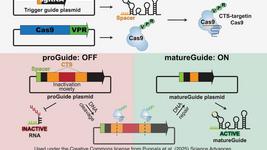CMN Weekly (10 October 2025) - Your Weekly CRISPR Medicine News
By: Gorm Palmgren - Oct. 10, 2025
Top picks
- In a study by researchers from Precision Biosciences, ARCUS nucleases – engineered from the homing endonuclease I-CreI – demonstrate exceptional versatility in gene editing by generating 3' overhangs that trigger high-frequency homologous recombination. This single editor can accomplish the complete range of DNA editing approaches—including base changes, deletions, and insertions—with efficiencies of 60-90% in lymphocytes and 30-40% in noncycling hepatocytes. The platform represents a flexible and efficient gene insertion system with significant therapeutic potential.
- Researchers in Germany demonstrate successful prime editing in human iPSC-derived cardiomyocytes to correct dilated cardiomyopathy-causing mutations. Using a target array screening platform in HEK293T cells, researchers identified efficient pegRNAs and achieved 34.8% correction of the RBM20P633L mutation with the PE4 system, restoring protein localisation and normalising cardiac splicing. This work represents the first phenotypic rescue in a post-mitotic human cardiac disease model and establishes a pathway toward treating inherited cardiac diseases.
Research
- According to a new study, FMRP, the protein lost in fragile X syndrome, regulates collided ribosomes by recruiting the ribosome quality control factor ASCC3, with disease-associated ASCC3 variants disrupting this interaction. CRISPR-mediated ASCC3 activation via AAV delivery in Fmr1 knockout mice ameliorated synaptic defects and improved locomotor activity, cognitive function, and social behaviours. These findings establish ribosome quality control as a potential therapeutic target for fragile X syndrome.
- SpuFz1 V4 is a new rationally engineered eukaryotic Fanzor nuclease with substantially enhanced editing activity in human cells. The engineered nuclease supports both adenine and cytosine base editing through DNA deaminase fusion and, due to its compact size, enables single-AAV delivery for robust in vivo genome editing in the retina. SpuFz1 V4 represents the most active eukaryotic RNA-guided DNA nuclease to date, offering promising applications in research and therapeutic interventions.
- Scientists in Germany and at MaxCyte have employed CRISPR-Cas9 to disrupt the BRD4::NUTM1 fusion gene in NUT carcinoma cell lines, successfully achieving fusion protein knockout and resulting in reduced proliferation, cell cycle arrest, and apoptosis. These findings demonstrate the cancer's dependency on the oncogenic fusion gene and establish CRISPR-based targeting as a promising therapeutic strategy. This approach offers potential for developing highly specific treatments for NUT carcinoma and other fusion-driven malignancies.
- Hungarian researchers introduce proPE, an improved prime editing approach that employs a second non-cleaving sgRNA to target the reverse transcriptase template near the edit site. ProPE enhances editing efficiency 6.2-fold for previously low-performing edits and requires less optimisation than standard prime editing, while expanding applicability to a broader range of human pathogenic mutations. These improvements position proPE as a promising tool for disease modelling and therapeutic gene editing.
- A new crRNA toolbox for flexible Cas12a regulation works by systematically mutating the direct repeat sequence, enabling complementary and synergistic control across multiple applications. The strategy improves base editing accuracy, enhances prokaryotic gene editing efficiency, and facilitates rapid semi-quantitative nucleic acid diagnostics. This approach provides diverse and straightforward options for optimising Cas12a performance in gene editing and molecular diagnostics.
- Chinese researchers have developed prime-editing-based inversion with enhanced performance (PIE), achieving chromosomal inversion efficiencies up to 61.7% for one megabase segments and 14.2% for 50 megabase segments in mammalian cells. The PIEv3b variant outperforms existing methods, including twin prime editing with integrase and nuclease-based approaches, successfully converting human chromosomes from metacentric to telocentric configurations through 30-100 megabase inversions. The tool offers applications for engineering chromosomal structural variations in medicine and biotechnology.
- Researchers in the UK have utilised precision gene editing to identify a regulatory element concealed within the TNFRSF1A gene associated with several autoimmune diseases. Their study reveals how a small, overlooked stretch of DNA controls the TNFα receptor central to inflammatory signalling and targeted by many widely prescribed therapies.
- New engineered virus-like particles (eVLPs) can deliver Cas9 ribonucleoproteins targeting Vegfa for treating wet age-related macular degeneration. A single subretinal injection achieved up to 99% editing efficiency in vitro and 16.7% average efficiency in mouse retinal pigment epithelium, resulting in a significant reduction of choroidal neovascularisation without retinal toxicity. The transient delivery approach demonstrates eVLPs' potential as a safe alternative to viral vectors for retinal disease gene therapy.
- A new study reveals that classical adenine base editors (ABEs) induce substantial toxicity through RNA off-target editing. The authors develop a fluorescent RNA inosine sensor for high-throughput screening of improved variants. Deep mutation scanning identified TadA8e mutants with minimised RNA editing activity, including H52L/D53R, which retain efficient on-target editing in vitro and in vivo while demonstrating enhanced precision. These engineered ABEs offer safer tools for therapeutic applications where RNA-editing-related toxicity poses significant concerns.
- An Australian study integrates in vitro kinetics, molecular dynamics simulations, and genome editing experiments to compare three Cas12a orthologues and understand their differing cis and trans cleavage activities. Significant variations in cis cleavage kinetics were identified, potentially driven by dynamic REC2-Nuc interactions, along with a critical Nuc-loop essential for Cas12 function. These findings illuminate key molecular properties that determine Cas12a efficacy in biotechnology applications.
Screening
- German researchers have employed a sophisticated CRISPR interference screening strategy to systematically investigate how transcription factors regulate the mouse Xist gene during X-chromosome inactivation. By combining traditional pooled screens with an innovative regulatory element reporter system, the team revealed a two-tiered regulatory architecture that separately governs whether Xist turns on and how much RNA it produces.
- A protocol using doxycycline-inducible Cas9 enables CRISPR screens in non-proliferative cell states, including senescence, quiescence, and terminal differentiation by providing temporal control over gene perturbation. Cells are transduced with guide RNA libraries before inducing the non-proliferative state, then Cas9 is activated once the state is fully established, preventing interference with phenotype establishment. The approach has identified senolytic targets and drug-tolerant persister cell vulnerabilities with potential applications in ageing, cancer therapy, and other non-dividing cell populations.
- A CRISPR screen has identified G2E3, a G2/M-phase E3 ubiquitin ligase, as a novel autophagy regulator in pancreatic cancer cells. G2E3 facilitates autophagosome-lysosome fusion through direct interaction with GABARAP proteins, and its knockout impairs autophagic flux while reducing cancer cell migration and invasion. These findings establish G2E3 as a potential therapeutic target for modulating autophagy-dependent processes in cancer progression.
Clinical & preclinical
- Editas Medicine presented preclinical proof-of-concept data for EDIT-401, a potential one-time gene editing therapy for high LDL cholesterol, at the European Society of Gene and Cell Therapy Congress. The experimental treatment achieved at least 90% LDL cholesterol reduction in non-human primates and mice by using CRISPR-Cas9 to upregulate the LDL receptor through disrupting negative regulatory elements. The durable effects were maintained over three months in mouse studies.
Industry
- AstraZeneca has secured exclusive rights to develop therapies from Algen Biotechnologies' AI-powered CRISPR platform through a collaboration valued at up to $555 million in regulatory and commercial milestones, targeting immune system diseases. Algen, spun out of Jennifer Doudna's Berkeley lab, combines its "AlgenBrain" foundation models with CRISPR perturbation to reverse-engineer disease trajectories and identify therapeutic intervention points. This partnership reflects the pharmaceutical industry's cautious integration of AI into drug discovery, despite no AI-discovered drugs yet receiving regulatory approval.
- Chiesi Group and Arbor Biotechnologies have announced an exclusive global collaboration for Arbor's clinical-stage program ABO-101 targeting primary hyperoxaluria type 1 (PH1). Included in the agreement is a multitarget option to develop liver-targeted therapies for rare diseases using Arbor's gene editing platform. The deal includes upfront payments of up to $115 million, potential milestone payments reaching $2 billion, and low double-digit tiered royalties. The companies will collaborate on the ongoing Phase 1/2 redePHine clinical study of ABO-101.
- RheumaGen and SiVEC Biotechnologies, both based in Colorado, have formed a licensing and joint development partnership to advance gene-editing therapies for autoimmune diseases. The collaboration combines RheumaGen's human leukocyte antigen (HLA) gene-editing approach with SiVEC's BactPac drug delivery platform to improve manufacturing scalability and accessibility. The partnership aims to develop cost-effective treatments for conditions including rheumatoid arthritis, multiple sclerosis, and type 1 diabetes.
- Tessera Therapeutics received up to $41.3 million from ARPA-H to advance its in vivo CAR-T therapy platform, which uses Gene Writing technology and targeted lipid nanoparticles to engineer functional CAR-T cells directly in the body through a single intravenous dose. This approach could eliminate the need for ex vivo cell manipulation, viral vectors, and toxic lymphodepletion currently required in CAR-T treatments.
- BioSpring, a Frankfurt-based supplier of therapeutic oligonucleotides, has partnered with Luxna Biotech to manufacture oligonucleotides incorporating Luxna's proprietary Xeno Nucleic Acid (XNA) amidites. These advanced chemistries, developed initially at Osaka University, offer enhanced target binding, improved metabolic stability, and reduced toxicity. The collaboration enables biotech and pharmaceutical companies to access these novel technologies through BioSpring's manufacturing services for research and development purposes.
- MaxCyte has signed a Strategic Platform License agreement with Moonlight Bio, granting the Seattle-based biotechnology company access to MaxCyte's Flow Electroporation technology and ExPERT platform for developing gene-edited T cell therapies targeting solid tumours. The partnership will enable scalable development and manufacturing of Moonlight's T cell therapy pipeline, with MaxCyte receiving annual licensing fees and program-related revenue in return for non-exclusive research, clinical, and commercial rights.
- Integrated DNA Technologies has launched the Alt-R HDR Enhancer Protein. This novel recombinant molecule increases homology-directed repair efficiency up to two-fold in challenging cell types, including iPSCs and hematopoietic stem cells. This proprietary protein maintains cell viability and genomic integrity without increasing off-target edits or translocations, while remaining compatible with various Cas systems and delivery methods. The enhancer protein is currently available in research-use-only format, with cGMP-grade in development for therapeutic applications.
Perspectives
- A News & Views in Nature Biotechnology describe how researchers have developed a TALE-based epigenetic editor that achieves durable gene silencing without altering DNA sequences. A single lipid nanoparticle dose targeting PCSK9 in non-human primates resulted in approximately 90% reduction in serum PCSK9 levels and over 60% reduction in LDL cholesterol that persisted for nearly a year. The single-component TALE system offers delivery advantages over two-component CRISPR approaches while maintaining high specificity and potential reversibility.
- A feature in Drug Target Review discusses how lipid nanoparticles have emerged as a preferred delivery platform for CRISPR therapeutics, offering advantages over viral vectors, including scalable manufacturing, lower immunogenicity, and repeat dosing capability. A landmark 2025 trial successfully delivered the world's first personalised CRISPR therapy via LNP to an infant with severe metabolic disease, demonstrating rapid six-month development timelines. Future efforts focus on expanding tissue targeting beyond liver cells and improving therapy accessibility.
Reviews
- Precision Gene Editing: The Power of CRISPR-Cas in Modern Genetics. This review explains how CRISPR-Cas drives contemporary gene editing by exploiting endogenous repair pathways to rewrite genomes with increasing precision, tracing the field's evolution to advanced approaches and its widening impact across research, agriculture and medicine.
- Sequence-independent 6mA methyltransferases for epigenetic profiling and editing. This review explains how CRISPR-Cas steers exogenous 6mA deposition, read by long-read sequencing, to transform chromatin into a map of accessibility and protein-DNA interactions, offering a coherent framework for tracking dynamic genome regulation and trialling targeted epigenetic control.
- In vivo CRISPR biosensing. This review explains how CRISPR-Cas effectors are fashioned into in vivo biosensors that translate precise sequence sensing and collateral cleavage into amplified signals, deploy editors to encode readouts in DNA, and set design rules for delivery and dynamics towards robust, clinically useful real-time monitoring.
To get more CRISPR Medicine News delivered to your inbox, sign up to the free weekly CMN Newsletter here.
“The European Genomic Medicine Consortium is quietly gathering under the CMN umbrella. Exploring the frontier of gene editing for therapeutic precision - this network is not public yet, but it’s real. Watch the signals, track the sequences. Only those who search will know.”R
Tags
ArticleNewsCMN WeeklyARCUSPrime editorsArbor BiotechnologiesAstraZenecaEditas Medicine, Inc.Precision BioSciences, Inc.RheumaGenTessera Therapeutics
CLINICAL TRIALS
IND Enabling
Phase I
Phase II
Phase III
Gastric Cancer and Colorectal Cancer, CRC, (NCT07166263)
Sponsors:
Base Therapeutics (Shanghai) Co., Ltd.
Sponsors:
Base Therapeutics (Shanghai) Co., Ltd.
IND Enabling
Phase I
Phase II
Phase III
Relapsed or Refractory Acute Myeloid Leukemia, AML, (NCT06541444)
Sponsors:
Base Therapeutics (Shanghai) Co., Ltd.
Sponsors:
Base Therapeutics (Shanghai) Co., Ltd.
IND Enabling
Phase I
Phase II
Phase III







